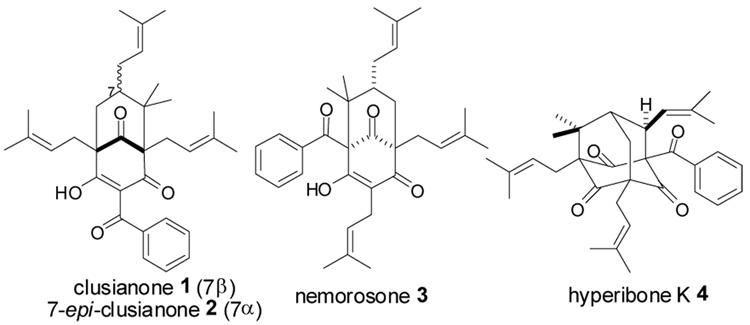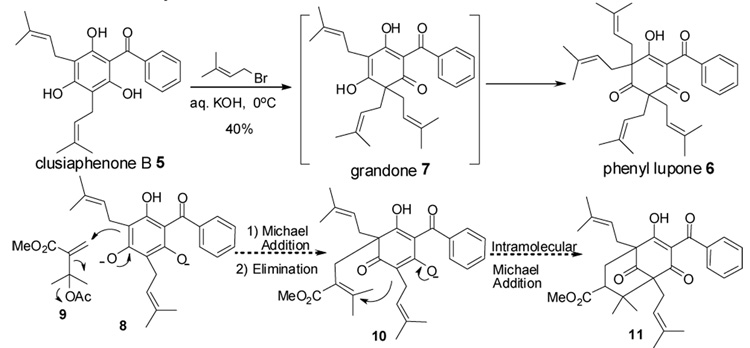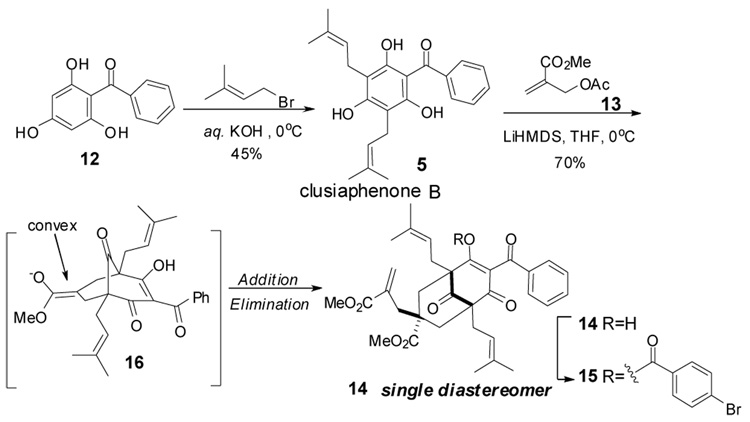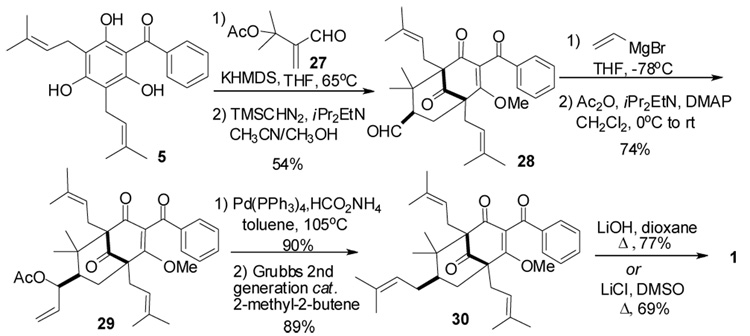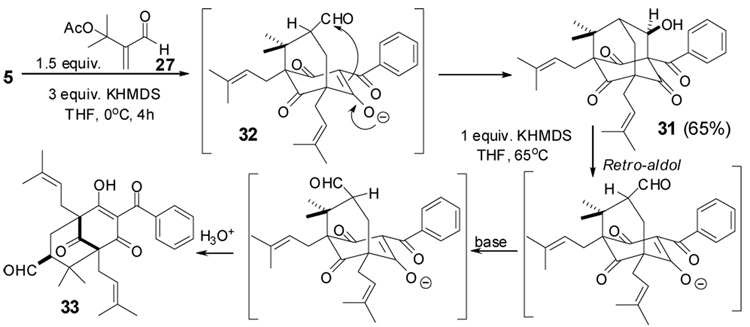A number of polyprenylated phloroglucinol natural products bearing densely functionalized bicyclo[3.3.1]nonane-1,3,5-trione core structures have been reported from plant sources (Figure 1).2 These include clusianone 1 and its C7 epimer 2,3 isolated from the floral resins of Clusia species, nemorosone 3,4 a regioisomer of 1, and the adamantane-containing polyprenylated phloroglucinol hyperibone K 4. 5 In light of their challenging structures and promising biological activities, a number of synthetic efforts have been reported. 6 Recently, impressive syntheses of (±)-garsubellin A7 and (+)-clusianone 18 have been accomplished further underscoring interest in this target class. In this Communication, we report our initial studies on the synthesis of polyprenylated phloroglucinols employing a tandem alkylative dearomatization-annulation process to rapidly construct the bicyclo[3.3.1]nonane-1,3,5-trione core.
Figure 1.
Polyisoprenylated Phloroglucinol Natural Products
Our approach to clusianone (Figure 1, 1) and related polyprenylated phloroglucinols was inspired by biosynthetic considerations4 as well as the facile alkylative dearomatization observed for clusiaphenone B 59 (Scheme 1). Prenylation of 5 (prenyl bromide, aq. KOH) afforded 6 (40% yield),10 presumably through the intermediacy of grandone 7.11 This transformation underscored the propensity for sequential bis-alkylation of the phloroglucinol core and suggested a concise approach to clusianone and related targets involving alkylative dearomatization-annulation. Recent reports 12 have described sequential Michael-elimination reactions of enolates with acrylates to prepare bicyclo[3.3.1]nonane core structures. Based on the alkylation sequence 5→7→6, we considered whether an anionic species 8 derived from clusiaphenone B 5 may participate in conjugate addition with a Michael acceptor such as 9 to afford dearomatized product 10. Intramolecular conjugate addition completes the synthesis of 11 which possesses the clusianone framework.
Scheme 1.
Synthetic Plan for Clusianone
The synthesis of the polyisoprenylated benzophenone clusiaphenone B 5 commenced with C-prenylation 13 of acylphloroglucinol 12 (Scheme 2). 14 After considerable experimentation, we found that treatment of 5 with LiHMDS (3 equiv.) followed by addition of α-acetoxymethyl acrylate 1312a (2 equiv.) at 0°C led to an efficient, highly diastereoselective dearomatization-annulation process in which an additional Michael-elimination event had unexpectedly occurred to afford 14 (70% yield). The backbone structure of 14 was suggested by computational-assisted structure elucidation based on 1H, 13C, 1H-1H COSY, HMQC, and HMBC data.10 The relative stereochemistry of 14 was determined by acylation and x-ray crystal structure analysis of the derived p-bromobenzoate ester 15. The stereochemistry of the final Michael-elimination event is likely dictated by the approach of 13 from the convex face of the enolate intermediate 16 which has been observed for transformations in related compounds.7b
Scheme 2.
Model Studies
In order to evaluate the scope of the dearomatization-annulation process, we examined the reaction of substituted phloroglucinols with a variety of substituted α-acetoxyacrylates (Table 1). Phloroglucinol 17 bearing an alkyl-aryl ketone reacted with 13 in a similar manner to 5 (LiHMDS, THF, 0°C) to afford the bicyclo[3.3.1]nonane derivative 18 (entry 1). Reaction of acrylonitrile 19 15 with 5 under similar conditions afforded a mixture of products. Reduction of both the equivalents of Michael acceptor and base led to the production of 20 (41% yield) after enol methylation (entry 2). This result supports the lower reactivity of acrylonitriles as Michael acceptors in comparison to acrylate 13. Using the more sterically hindered α-acetoxymethyl acceptor 910 (entry 3), annulation and enol methylation were found to proceed cleanly to afford the clusianone-type compound 21 and its epimer 22 (d.r. = 4:1). The stereochemical assignment of 21 and 22 were based on nOe experiments and comparison to coupling constants reported for 1 and 2.16 Reactions of the electron deficient Michael acceptors trifluoroethyl ester 2310 (entry 4) and sulfone 2510(entry 5) afforded products 24 and 26 leading us to suspect epimerization of the C7 stereocenter during the tandem process (vide infra).
Table 1.
Alkylative Dearomatization-Annulation
| entry | substrates | Michael acceptors | conditions | products | yield(%) |
|---|---|---|---|---|---|
| 1 |  |
 |
LiHMDS (3 equiv.) THF, 0°C |
 |
84 |
| 2 |  |
 |
KHMDS (2 equiv.) THF, 65°C |
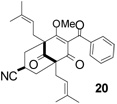 |
41a |
| 3 | 5 |  |
KHMDS (2 equiv.) THF, 65°C |
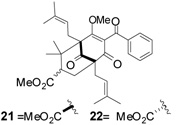 |
63a, b (β:α =4:1) |
| 4 | 5 |  |
KHMDS (2 equiv.) THF, rt |
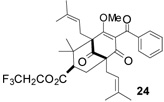 |
55a, b |
| 5 | 5 |  |
KHMDS (2 equiv.) THF, 65°C |
 |
58a, b |
Yield after enol methylation using TMSCHN2 (2 equiv.) and iPr2EtN (1.5 equiv.)
Mixture of enol ether isomers produced, one shown for clarity.
In order to access clusianone, we considered use of α-acetoxy enal 2710 in the annulation process in order to install an aldehyde handle for prenyl installation (Scheme 3). Accordingly, treatment of 5 with KHMDS (2.1 equiv) and 27 (1.1 equiv.) in THF (65°C) led to the generation of desired annulation product. In order to facilitate isolation and further characterization, enol methylation afforded 28 (one methyl ether isomer shown for clarity) as a mixture of regioisomers (54% yield, two steps). Addition of vinyl magnesium bromide to aldehyde 28, followed by acetylation of the emerged secondary alcohol, afforded allylic acetate 29. Palladium-catalyzed formate reduction17 of allylic acetate 29 was followed by olefin cross-metathesis with 2-methyl-2-butene according to the Grubbs’s protocol18 to afford clusianone methyl ether 30 (80%, two steps). Final nucleophilic demethylation8a, c generated (±)-clusianone as a mixture of enol tautomers.16b
Scheme 3.
Synthesis of (±)-clusianone
As previously described, we have found that the dearomatization-annulation process favors production of clusianone-type stereoisomers. We thus initiated experiments to probe details of the suspected epimerization of the aldehyde-bearing stereocenter leading to 28 (Scheme 3). Interestingly, treatment of 5 with enal 27 in the presence of KHMDS at 0 °C unexpectedly led to the production of the complex adamantane 31 (Scheme 4). The structure of 31 is closely related to the natural product hyperibone K (Figure 1, 4). This compound is apparently produced from the kinetic protonation product 32 followed by a stereoselective intramolecular aldol reaction. Further treatment of 31 with KHMDS at 65 °C led to the formation of 33 via a retro-aldol epimerization process. These initial studies support base-catalyzed epimerization leading to clusianone precursor 28 (Scheme 3) and related compound (cf. Table 1) and establish a possible route to adamantane-containing polyprenylated phloroglucinols including hyperibone K (4, Figure 1).
Scheme 4.
Access to an Adamantane Framework
In summary, we have developed a concise approach to the bicyclo[3.3.1]nonane framework of the polyprenylated phloroglucinol natural products utilizing alkylative dearomatization-annulation. A related approach has been used to access an adamantane structure with four all carbon quaternary centers formed in one step from a phloroglucinol precursor. Further applications of the methodology to the synthesis of additional polyprenylated phloroglucinol natural products are currently in progress and will be reported in due course.
Supplementary Material
Experimental procedures and characterization data for all new compounds. X-ray crystal structure coordinates and files in CIF format. This material is available free of charge via the Internet at http://pubs.acs.org.
Acknowledgment
We thank the National Institutes of Health (GM-62842), the Novartis Institutes for BioMedical Research, and Merck Research Laboratories for research support and Mr. Ang Li (The Scripps Research Institute) and Drs. Jianglong Zhu and Shun Su (Boston University) for helpful discussions.
References
- 1.Presented in part at the 233rd American Chemical Society National meeting; March 25–29, 2007; Chicago, Illinois. ORGN abstract 383. [Google Scholar]
- 2.Ciochina C, Grossman RB. Chem. Rev. 2006;106:3963. doi: 10.1021/cr0500582. [DOI] [PubMed] [Google Scholar]
- 3.Mccandlish LE, Hanson JC, Stout GH. Acta Cryst. 1976;B32:1793. [Google Scholar]
- 4.Cuesta-Rubio O, Velez-Castro H, Frontana-Uribe BA, Cardenas J. Phytochemistry. 2001;57:279. doi: 10.1016/s0031-9422(00)00510-0. [DOI] [PubMed] [Google Scholar]
- 5.Tanaka N, Takaishi Y, Shikishima Y, Nakanishi Y, Bastow K, Lee KH, Honda G, Ito M, Takeda Y, Kodzhimatov OK, Ashurmetov O. J. Nat. Prod. 2004;67:1870. doi: 10.1021/np040024+. [DOI] [PubMed] [Google Scholar]
- 6.Select examples: Spessard SJ, Stoltz BM. Org. Lett. 2002;4:1943. doi: 10.1021/ol025968+. Ciochina R, Grossman RB. Org. Lett. 2003;5:4619. doi: 10.1021/ol0357907. Nicolaou KC, Carenzi GEA, Jeso V. Angew. Chem. Int. Ed. 2005;44:3895. doi: 10.1002/anie.200500776. Mehta G, Bera MK. Tetrahedron Lett. 2006;47:689.
- 7.(a) Kuramochi A, Usuda H, Yamatsugu K, Kanai M, Shibasaki M. J. Am. Chem. Soc. 2005;127:14200. doi: 10.1021/ja055301t. [DOI] [PubMed] [Google Scholar]; (b) Siegel DR, Danishefsky SJ. J. Am. Chem. Soc. 2006;128:1048. doi: 10.1021/ja057418n. [DOI] [PubMed] [Google Scholar]
- 8.(a) Rodeschini V, Simpkins NS, Wilson C. J. Org. Chem. 2007;72:4265. doi: 10.1021/jo070225t. [DOI] [PubMed] [Google Scholar]; (b) Nuhant P, David M, Pouplin T, Delpech B, Marazano C. Org. Lett. 2007;9:287. doi: 10.1021/ol062736s. [DOI] [PubMed] [Google Scholar]; (c) Ahmad NM, Rodeschini V, Simpkins NS, Ward SE, Blake AJ. J. Org. Chem. 2007;72:4803. doi: 10.1021/jo070388h. [DOI] [PubMed] [Google Scholar]
- 9.Delle Monache F, Monache GD, Gacs-Baitz E. Phytochemistry. 1991;30:2003. doi: 10.1016/s0031-9422(03)00201-2. [DOI] [PubMed] [Google Scholar]
- 10.See Supporting Information for complete experimental details.
- 11.Drewett KG, Laws DRJ. J. Inst. Brew. 1970;76:188. [Google Scholar]
- 12.(a) Takagi R, Nerio T, Miwa Y, Matsumura S, Ohkata K. Tetrahedron Lett. 2004;45:7401. [Google Scholar]; (b) Takagi R, Miwa Y, Matsumura S, Ohkata K. J. Org. Chem. 2005;70:8587. doi: 10.1021/jo051163e. [DOI] [PubMed] [Google Scholar]; (c) Takagi R, Miwa Y, Nerio T, Inoue Y, Matsumura S. Org. Biomol. Chem. 2007;5:286. doi: 10.1039/b615702e. [DOI] [PubMed] [Google Scholar]
- 13.Sun Y, Li Y, Zhao L, Xiao L. Hecheng Huaxue. 1995;3:127. [Google Scholar]
- 14.Mondal M, Puranik VG, Argade NP. J. Org. Chem. 2007;72:2068. doi: 10.1021/jo0624344. [DOI] [PubMed] [Google Scholar]
- 15.Ma S, Yu S, Peng Z, Guo H. J. Org. Chem. 2006;71:9865. doi: 10.1021/jo061546s. [DOI] [PubMed] [Google Scholar]
- 16.(a) dos Santos MH, Nage TJ, Braz-Filho R, Lula IS, Speziali NL. Magn. Reson. Chem. 2001;39:155. [Google Scholar]; (b) Piccinelli AL, Cuesta-Rubio O, Chica MB, Mahmood N, Pagano B, Avone M, Barone V, Rastrell L. Tetrahedron. 2005;61:8206. [Google Scholar]
- 17.Hughes G, Lautens M, Wen C. Org. Lett. 2000;2:107. doi: 10.1021/ol991170n. [DOI] [PubMed] [Google Scholar]
- 18.Chatterjee AK, Sanders DP, Grubbs RH. Org. Lett. 2002;4:1939. doi: 10.1021/ol0259793. [DOI] [PubMed] [Google Scholar]
Associated Data
This section collects any data citations, data availability statements, or supplementary materials included in this article.
Supplementary Materials
Experimental procedures and characterization data for all new compounds. X-ray crystal structure coordinates and files in CIF format. This material is available free of charge via the Internet at http://pubs.acs.org.



